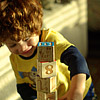
Session Overview
 |
Do you remember your life as a young child? What capabilities to infants have? What are the stages of physical and cognitive development after birth? In this lecture, we will explore the major milestones of infancy and the theories and phenomena that often accompany this progression. Keywords: child development, Piaget, nature/nurture, neotony Photo courtesy of Adam Baker on Flickr. CC-BY. |
Session Activities
Readings
Read the following before watching the lecture video.
- Begin one of these chapters in your chosen textbook:
Lecture Videos
View Full Video
- Lecture 17: Child Development (00:33:25)
View by Chapter
- Introduction and Neotony (00:03:13)
- How Babies Learn (00:07:59)
- Piaget and the Sensorimotor Stage (00:07:22)
- Piaget and the Preoperational Stage (00:02:04)
- Theory of Mind (00:07:47)
- Babies and Mathematicians (00:03:28)
Video Resources
Check Yourself
1) According to Piaget's stages of cognitive development, the _______________ stage is when children acquire the ability to internally represent the world through language and mental imagery. They also start to see the world from other people’s perspectives.
- Formal operational
- Sensorimotor
- Preoperational
- Concrete operational
› View/Hide Answer
C, preoperational. (Stangor, Table 6.3)
2) One of the most important behaviors a child must learn is how to be accepted by others—the development of close and meaningful social relationships. The emotional bonds that we develop with those with whom we feel closest, and particularly the bonds that an infant develops with the mother or primary caregiver, are referred to as attachment. Please describe the four types of attachment and give an example of each.
› Sample Answers
A child with a secure attachment style usually explores freely while the mother is present and engages with the stranger. The child may be upset when the mother departs but is also happy to see the mother return.
A child with an ambivalent (sometimes called insecure-resistant) attachment style is wary about the situation in general, particularly the stranger, and stays close or even clings to the mother rather than exploring the toys. When the mother leaves, the child is extremely distressed and is ambivalent when she returns. The child may rush to the mother but then fail to cling to her when she picks up the child.
A child with an avoidant (sometimes called insecure-avoidant) attachment style will avoid or ignore the mother, showing little emotion when the mother departs or returns. The child may run away from the mother when she approaches. The child will not explore very much, regardless of who is there, and the stranger will not be treated much differently from the mother.
A child with a disorganized attachment style seems to have no consistent way of coping with the stress of the strange situation—the child may cry during the separation but avoid the mother when she returns, or the child may approach the mother but then freeze or fall to the floor. (Flatworld: p. 175)
Further Study
Writing Assignment 2: Admission of a "recovered memory" in a court case.
These optional resources are provided for students that wish to explore this topic more fully.
| TYPE | CONTENT | CONTEXT |
|---|---|---|
| Webpage | Infant Cognition Lab | A University of Illinois lab, headed by Dr. Renée Baillargeon, focusing on cognitive development during the first three years of life. |
| Article | Scott, Paul. "Kid Rock." New York Times Magazine. April 2, 2006. | An article on "The Wiggles," a music group that writes music and performs for young children. |
| Textbook supplement | Study materials for Ch. 12 "Psychology Over the Lifespan: Growing Up, Growing Older, Growing Wiser." In Kosslyn & Rosenberg, Psychology in Context, 3/e (Pearson, 2007) | Practice test questions, flashcards, and media for a related textbook |
